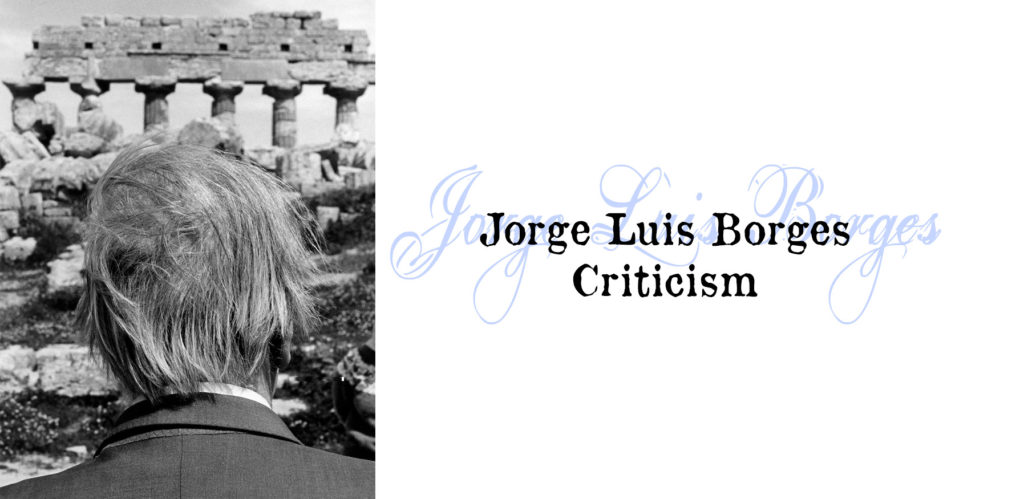Borges Criticism – General Criticism 1957–1986
- At August 22, 2019
- By Great Quail
- In Borges
 0
0
Any time something is written against me, I not only share the sentiment but feel I could do the job far better myself. Perhaps I should advise would-be enemies to send me their grievances beforehand, with full assurance that they will receive my every aid and support. I have even secretly longed to write, under a pen name, a merciless tirade against myself.
—Jorge Luis Borges, Autobiographical Essay 1970
Borges Criticism: General Criticism 1957–1986
This page collects literary criticism written about Borges during his lifetime. All of these works are available in English, and focus on “general criticism” such as surveys, compendiums and correspondences, conference proceedings, traditional literary analysis, and so on. (A complete list of Borges Criticism can be accessed at the bottom of the page.) The books are listed in chronological order of publication. Clicking the image of a book takes you directly to Amazon.com. Wherever possible, links to the Internet Archive are provided. These “online editions” may or may not match the exact edition of the corresponding book.
Each book contains a brief description and a summary of its contents. Some have also been reviewed. If any knowledgable visitor would like to submit comments for any of the “unreviewed” works, please contact the Garden!
La expresión de la irrealidad en la obra de Jorge Luis Borges
Borges the Labyrinth Maker
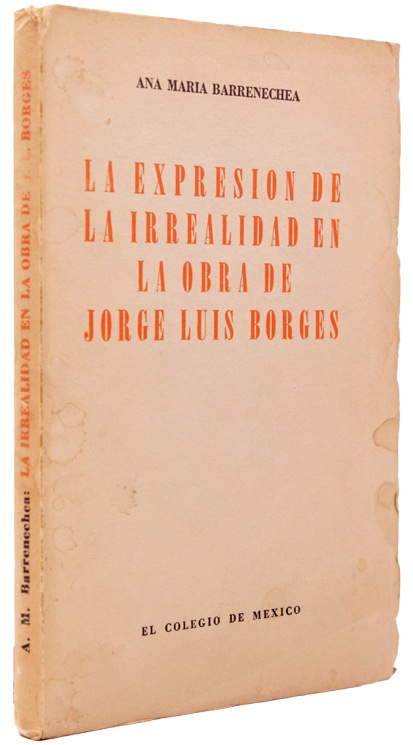 La expresión de la irrealidad en la obra de Jorge Luis Borges By Ana María Barrenechea Mexico DF: El Collegio de Mexico, 1957 |
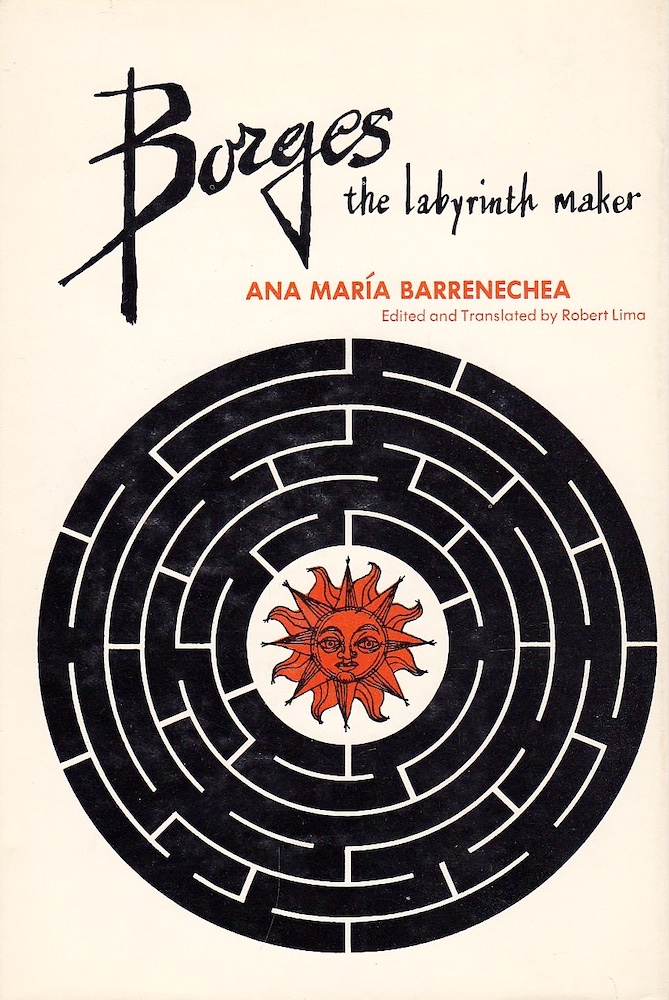 Borges the Labyrinth Maker By Ana María Barrenechea Foreword by Jorge Luis Borges Translation by Robert Lima New York University Press, 1965 Online at: Internet Archive |
Ana María Barrenechea (1913-2010) was an Argentine linguist who studied under the literary critics Amado Alonso and Pedro Henríquez Ureña. Receiving a Ph.D. from Bryn Mawr, her doctoral thesis was “La expresión de la irrealidad en la obra de Borges,” or “The Expression of Unreality in the Work of Borges.” An examination of common themes found in Borges’ major stories, Barrenechea’s dissertation was the first critical attempt to outline a “Borgesian cosmology.” It was first published in book form by El Collegio de Mexico in 1957. In 1965, a revised and expanded edition was translated into English by Robert Lima and published by New York University Press as Borges the Labyrinth Maker.
Publisher’s Description: In this incisive study María Barrenechea explores “the driving trend behind the symbols,” the forces that give shape and coherence to Borges’ resplendent world of shadows. Borges’ metaphysical preoccupations, his fascination with the intricacies of language, his very special vocabulary of doubt, and his sure mastery of structure—Professor Barrenechea illuminates each of these key elements with a close and steady examination of the work itself, and especially the short stories. The result is a book that makes available for the first time in English a detailed critical study, including a biographical sketch and an extended bibliography, of one of the most commanding writers of our time.
Table of Contents:
Foreword by Jorge Luis Borges
1. Borges: Life and Works
2. The Infinite
3. Chaos and the Cosmos
4. Pantheism and Personality
5. Time and Eternity
6. Idealism and Other Forms of Unreality
7. Conclusion
Reviews: As Borges himself writes in the foreword, “Professor Barrenechea’s book has taught me many things about myself.” Whether his statement was genuine or ironic is open to question, as few contemporary critics were eager to challenge Barrenechea’s understanding. Reviewing the book for Modern Language Quarterly in 1966, Ray Verzasconi praised her scholarship, but lamented Barrenechea’s interpretation of Borges as a fatalist:
Of the numerous works devoted to [Borges’] defense, none has been attempted with as much ambition and erudition as has the current volume. The author’s purpose, as stated on several occasions, is to analyze the aesthetic function of “all the forms of the expressions of unreality” which appear throughout Borges’ work. […] Concerning each theme, she considers, with methodical skill, the philosophical and literary allusions, the special vocabulary, the symbols, the metaphors, the structure of the narratives, and the syntax which, together, form that body of expressions of unreality. In addition, she also comments upon the literary and philosophical sources of these themes.
For the sheer enumeration of these “forms of the expression of unreality,” the study is overwhelming. By placing together numerous quotations dealing with the five major themes, and many minor ones, Barrenechea succeeds not only in illuminating those themes which have most often attracted Borges’ attention, but also in compiling an impressive list of his favorite rhetorical devices.
Beyond that enumeration, however, the study is extremely disappointing. First of all, the author assumes a priori that Borges is a writer pledged to destroy “man’s belief in the concreteness of his life.” Therefore, she makes a special effort to point out those places in which Borges’ fictional world of unreality is focused upon the deceitfulness of the real world upon the futility of ever understanding it. Yet, her one-sided approach proves unsatisfactory as a means of analyzing fully the meaning of Borges’ mediums of literary expression. Throughout the context of the main chapters, she concludes that the role of all “forms of the expression of unreality” is one constantly calculated to produce anguish and disillusionment.
Verzasconi goes on to suggest that Barrenechea overlooks Borges’ sense of playfulness and irony; conclusions not too difficult to reach. The importance of Barrenechea’s work to early Borges scholarship is indisputable, but Borges the Labyrinth Maker suffers from its origin as an academic dissertation—it’s drily written, pedantic in its pursuit of unifying idea, and filled with distracting quotations.
The Narrow Act
Borges’ Art of Allusion
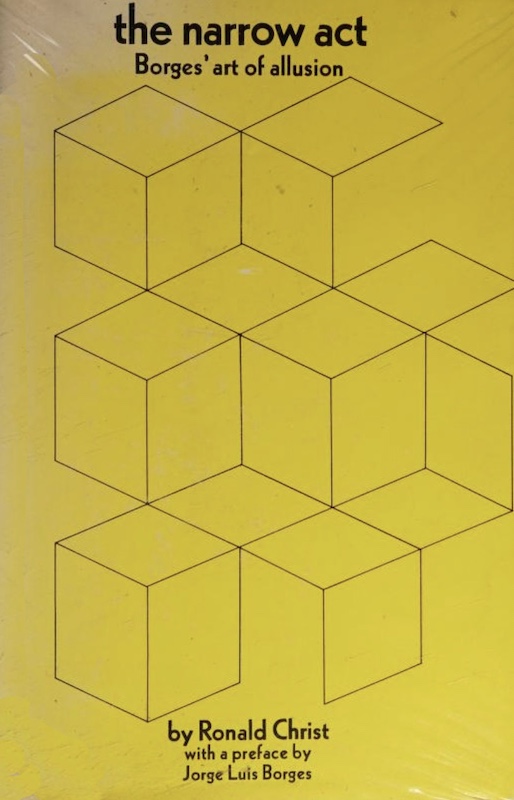 The Narrow Act: Borges’ Art of Allusion By Ronald Christ Preface by Jorge Luis Borges New York University Press, 1969 Online at: Internet Archive |
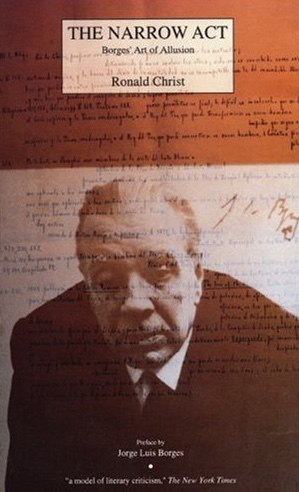 The Narrow Act: Borges’ Art of Allusion By Ronald Christ Preface by Jorge Luis Borges Lumen Books, 1995 |
Ronald Christ is an American linguist who studied under Gregory Rabassa, the translator of Gabriel García Márquez’ One Hundred Years of Solitude. Christ directed the literature program at the Center for Inter-American Relations in New York City, taught at Rutgers University, and co-founded Lumen Books and SITES magazine. He wrote his doctoral thesis on Borges, for which he received a NEH grant to visit Buenos Aires. The Narrow Act is an expansion of that dissertation, and has the distinction of being the first serious study of Borges written in English. It features a preface written by Borges himself, who later remarked that “of the many books dealing with my work, [The Narrow Act] is the best, the most intelligent, and the most carefully done. In fact, I would call it a remarkable piece of readable and meaningful scholarship.”
In 1995 the book was revised and reissued by Lumen Books, a publishing house Ronald Christ co-founded in 1979 with Dennis Dollens to promote translations of Hispanic writing. For this edition, Christ corrected several errors and included an extensive interview he conducted with Borges in 1966 for the Paris Review.
Reviews: Peter G. Earle’s review of The Narrow Act was published in Comparative Literature Studies, Vol. 9, No. 3 (Sep. 1972): pp. 354–357, [JSTOR paywall]. Robert Lima’s review appeared in Romanic Review, Vol. 62, Issue 2 (April 1971): pg. 163, [ProQuest paywall].
The Mythmaker
A Study of Motif and Symbol in the Short Stories of Jorge Luis Borges
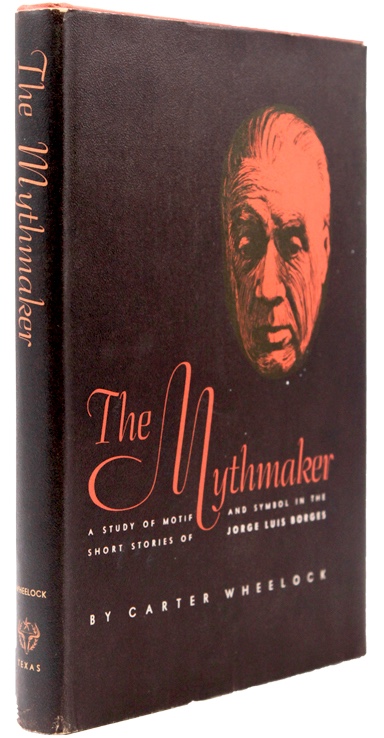
The Mythmaker: A Study of Motif and Symbol in the Short Stories of Jorge Luis Borges
By Carter Wheelock
Austin: University of Texas Press, 1969
Online at: Internet Archive
Carter Wheelock (1924–2013) was a professor of Spanish at the University of Texas at Austin. Long associated with Borges, Wheelock had taken Borges’ 1961 class at Austin, and wrote his dissertation on Borges’ fiction, a thesis that was eventually transformed into The Mythmaker.
Publisher’s Description: Readers who are intrigued, though often mystified, by the intellectual fantasies of Jorge Luis Borges will find this book a revelation, a skeleton key to one of the most fundamental and baffling aspects of Borges’s fictions: the pattern of symbolism with an inner meaning. Carter Wheelock’s study reduces a number of literary and intellectual abstractions to concrete terms, enabling the reader to understand Borges’s fantasies in ways that show them to be not so fantastic after all. Indeed, they are amazingly consistent and minutely accurate in their symbolic depiction of the magic universe of the mind. Wheelock also discusses the affinity between Borges’s philosophical idealism and his “esthetic of the intelligence,” the relationship between these and the esthetic ideas of French Symbolism, and the influence on his fictions of the Rubáiyát of Omar Khayyám. Why is it that this “writer’s writer” from the Argentine—erudite, allusive, elusive—has attracted such international attention? In Wheelock’s opinion, it is because he has symbolized in his short stories the fundamental form of the human consciousness, the functioning of the imaginative (world-creating) mechanism, and the eternal battle between form and chaos. The Mythmaker is concerned with elucidating the particulars of Borges’s fictional works, but even as it does so it also reveals their universality.
Table of Contents:
1. Borges, Symbolism, and the Esthetic Phenomenon
2. The Rending of the Veil
3. The Radical Regression
4 The Symbols of the Zahir
5. The Recurrence of the Motif
Bibliography
Index
Reviews: Evelio Echevarría’s review of The Mythmaker appeared in Studies in Short Fiction, Vol. 7, Issue 4 (Fall 1970): pg. 655, [ProQuest paywall].
Additional Information
In 2011, the writer Eric Benson traveled to Austin for the fiftieth anniversary of Borges’ visitation. He looked up Carter Wheelock, who had retired from teaching. Wheelock’s remembrances about Borges are worth reading, and are captured in “Forgotten But Not Gone,” Bensen’s article for Guernica.
Jorge Luis Borges
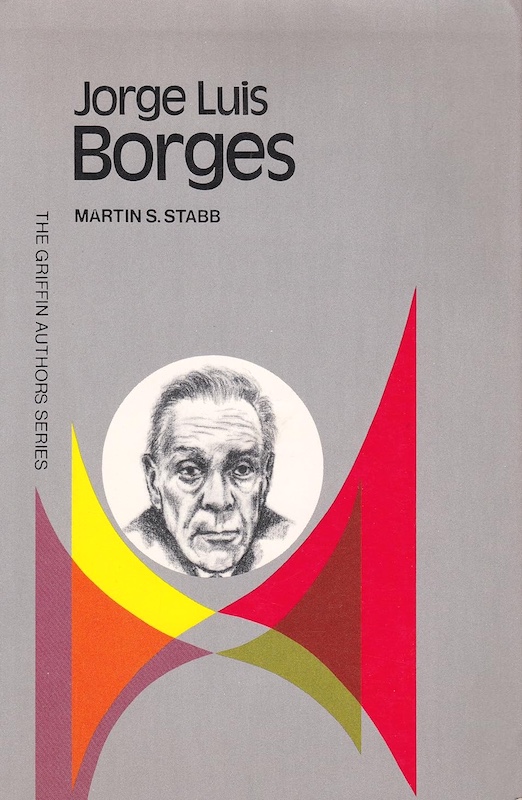
Jorge Luis Borges
By Martin S. Stabb
Twayne Publishing, 1970
Martin Stabb is a professor of Romance Languages at the Pennsylvania State University. Jorge Luis Borges was published as part of Twayne’s “Griffin Author Series,” and was intended to serve as a “student introduction” to Borges and early Borges criticism.
Table of Contents:
Preface
Chronology
1. Borges: The Man and His Time
2. Borges the Poet
3. Borges the Essayist
4. Borges the Writer of Fiction
5. Borges and the Critics
Notes and References
Selected Bibliography
Martin Stabb returned to Borges in 1991 for Borges Revisited, essentially an expansion of this book.
The Cardinal Points of Borges
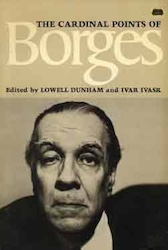
The Cardinal Points of Borges
Edited by Lowell Dunham & Ivar Ivask
University of Oklahoma Press, 1971
Online at: Internet Archive
The Cardinal Points of Borges is a compilation of papers from the International Symposium on Borges, held at the University of Oklahoma on December 5–6, 1969. Borges himself was in attendance.
Table of Contents: The Cardinal Points of Borges contains the following essays, with some available as PDFs from the Borges Center:
- Jorge Luis Borges, “Browning resuelve ser poeta” (“Browning decides to be a poet,” translated by Norman Thomas di Giovanni.)
- J. Guillén, “Encyclopaedia Britannica”
- J. Guillén, “Humilde irrealidad”
- J. Guillén, “Elogio de la sombra”
- Ronald Christ, “A Modest Proposal for the Criticism of Borges”
- Emir Rodríguez Monegal, “In the Labyrinth”
- Donald A. Yates, “The Four Cardinal Points of Borges”
- J.E. Irby, “Borges and the Idea of Utopia”
- Jaime Alazraki, “Oxymoronic Structure in Borges’ Essays”
- J.C. Murchison, “The Visible Work of Macedonio Fernández”
- Norman Thomas di Giovanni, “At Work with Borges”
- Jorge Luis Borges, “Appendix: Pedro Salvadores”
- Ivar Ivask, “Borges in Oklahoma 1969”
- R.L. Fiore, “Toward a Bibliography on Jorge Luis Borges (1923-69)”
Reviews: Mary G. Berg’s review of The Cardinal Points of Borges was published in Modern Fiction Studies, Vol. 19, No. 3 (Autumn 1973): pp. 469–474, [JSTOR paywall].
Additional Information
Norman Thomas di Giovanni’s “At Work with Borges” is available behind the JSTOR paywall. It also includes “Appendix: Pedro Salvadores.”
Jorge Luis Borges
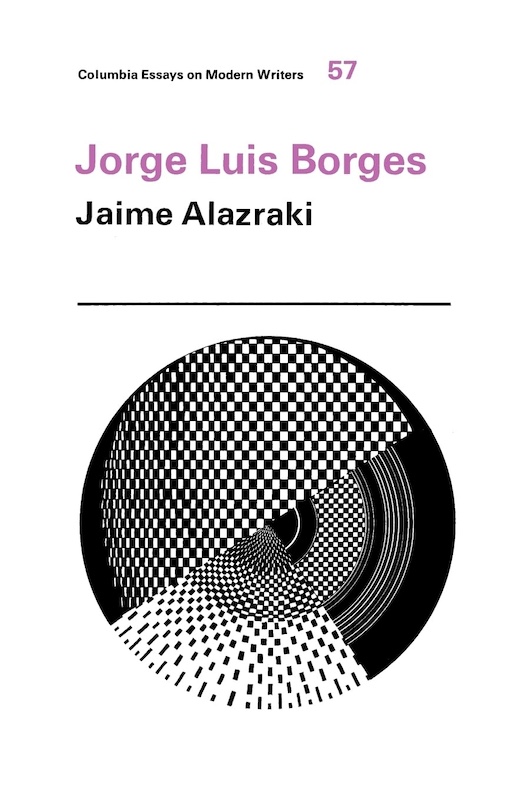
Jorge Luis Borges
By Jaime Alazraki
Columbia University Press, 1971
Online at: Internet Archive
Born in Argentina, Jaime Alazraki (1934–2014) was a literary critic who received his Ph.D. in philosophy from Columbia University. A world-renown Borges scholar, Alazraki’s first work was a 1969 study of Borges published in Madrid as La prosa narrative de J.L. Borges. In 1971, Columbia University invited him to write a general survey of Borges as part of their “Columbia Essays on Modern Writers” series, edited by the Joycean scholar William York Tindall. Jorge Luis Borges was Number 57 in that series. Under 50 pages in length, the book is essentially an essay that outlines the principal themes of Borges’ major stories. Alazraki was fascinated by Jewish mysticism, and his fascination with esoteric belief systems informs many of his thoughts and interpretations. Alazraki writes in a formal but direct style: drily professorial, yet free from unnecessary academic jargon. In 1988 Alazraki returned to Columbia University to chair the department of Spanish and Portuguese. That same year he published Borges and the Kabbalah: And Other Essays on His Fiction and Poetry.
Reviews: Mary G. Berg’s review of Jorge Luis Borges was published in Modern Fiction Studies, Vol. 19, No. 3 (Autumn 1973): pp. 469–474, [JSTOR paywall].
Prose for Borges
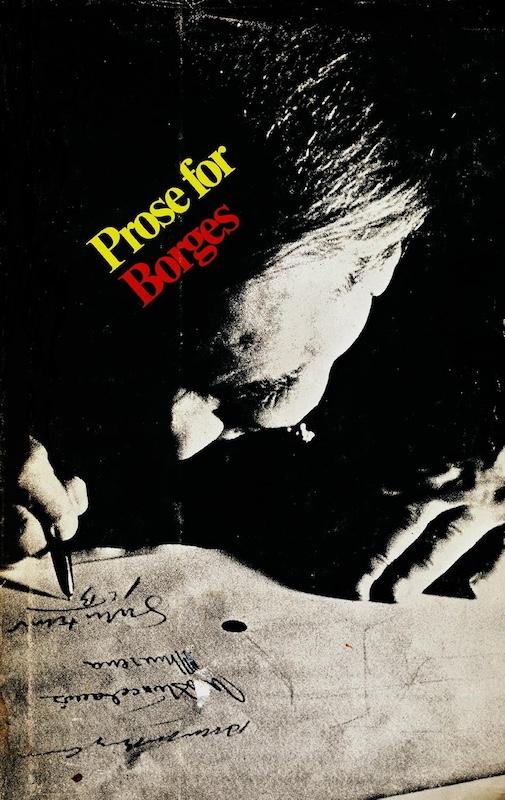
Prose for Borges
Edited by Mary Kinzie & Charles Hamilton Newman
Consulting Editor: Norman Thomas di Giovanni
Northwestern University Press, 1974
Online at: Internet Archive
This collection of Borges-related essays and papers was compiled and edited by Mary Kinzie, a poet and critic from the Johns Hopkins University; Charles Hamilton Newman, the author of The Post-Modern Aura and former editor of TriQuarterly; and Norman Thomas di Giovanni, the famous Borges translator. A significant collection for its time, it featured most of the preeminent Borges scholars of the mid-twentieth century, along with Borges’ most important collaborators, editors, and translators.
Table of Contents:
- Mary Kinzie, “Preface for the Americans”
- Richard Howard, “Prose for Borges”
- Ronald Christ, “Borges Justified: Notes and Texts Towards Stations of a Theme”
- Néstor Ibarra, “From Borges et Borges: The Final Dialogues”
- Alastair Reid, “Borges as Reader”
- Emir Rodríguez-Monegal, “Borges: The Reader as Writer”
- R.H.W. Dillard, “The Past Tense, Three Poems”
- Humberto M. Rasi, “The Final Creole: Borges’ View of Argentine History”
- Adolfo Bioy Casares, “On Fantastic Literature”
- Kenneth Fields, “Business from Porlock”
- Jaime Alazraki, “Borges and the Kabbalah”
- Ben Belitt, “The Enigmatic Predicament: Some Parables of Kafka and Borges”
- Anthony Kerrigan, “Borges/Unamuno”
- John C. Murchison, “The Greater Voice: On the Poetry of Jorge Luis Borges”
- Robert Alter, “Borges and Stevens: A Note on Post-Symbolist Writing”
- John Wright, “Borges and Hawthorne”
- Alexander Coleman, “Note on Borges and American Literature”
- Jaime Alazraki, “Borges and the New Latin-American Novel”
- Frank Macshane, “Borges the Craftsman”
- Carter Wheelock, “Borges’ New Prose”
- Victoria Ocampo, “Interview with Norah Borges”
- Ronald Christ, “Borges at NYU”
- John Hollander, “Index: homage to Borges”
- Norman Thomas di Giovanni, “Checklist of the Principal Works”
Critical Guides to Spanish Texts:
Borges Ficciones
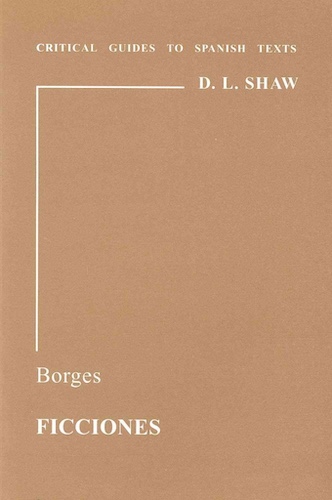
Critical Guides to Spanish Texts: Borges Ficciones
By Donald L. Shaw
1. Grant & Cutler, 1976
2. Foyles, 2nd Revised edition, 1993
Online at: Internet Archive
Donald Leslie Shaw (1930-2017) was the Brown-Forman Professor of Spanish American Literature at the University of Virginia. His survey of Borges’ Ficciones is Book 14 in Grant & Cutler’s “Critical Guides to Spanish & Latin American Texts and Films,” designed to “introduce to graduate and undergraduate students some of the major texts of Hispanic literature.” The book contains an essay on every story in Ficciones, plus notes on “Borges’ Fictional Style.” In 1993, Shaw revised the book for a second edition.
Paper Tigers
The Ideal Fictions of Jorge Luis Borges
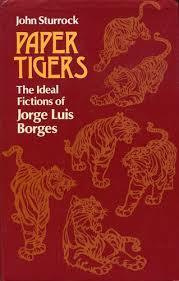
Paper Tigers: The Ideal Fictions of Jorge Luis Borges
By John Sturrock
Oxford University Press, 1977
Online at: Internet Archive
John Sturrock (1930–2017) was a writer and translator who edited the Times Literary Supplement and the London Review of Books. An influential work when it was first published, Paper Tigers approaches Borges from a structuralist perspective, holding up his stories as exemplars of pure “fictionality”—Borges is seen as the master of the “think-piece,” or “stories about ideas instead of people.” Sturrock claims that by de-emphasizing characterization, Borges privileges pure artifice and creativity over the compromising demands of literary realism or psychology. Although Sturrock makes a convincing argument, numerous critics have faulted him for failing to recognize the more human elements in Borges’ work. Still, it is a thought-provoking and insightful analysis, and Paper Tigers is long overdue for a reprint.
Publisher’s Description: Papers tigers are figments, creatures of the imagination which are as close as any writer can come to the real flesh-and-blood animal. Tigers recur in the writings of the Argentinian Jorge Luis Borges as symbols of the achievements and frustrations of working only with words. Borges is among the most acute and comprehensive of the world’s literary thinkers. This book is an analytical study of his short stories, and especially of the earlier, more intricate ones published in Ficciones and El Aleph. It shows how these stories exemplify the rules and artifices of fiction in general, and the extent to which Borges has merged the practice and the theory of narrative. John Sturrock sees Borges more as a craftsman than as a metaphysician or prophet, and places him squarely in the reflective tradition of twentieth-century fiction in which the narrative dramatizes the distinctive procedures of fiction itself. His book will interest those who wish to understand something of the theory of fiction, as well as those seeking a closer understanding of one of the most subtle, amusing, and unusual writers of this century.
Table of Contents:
Part I
-
- The Argentinian
- The Metaphysician
Part II
-
- Isolation
- Inspiration
- Idealization
Part III
-
- Concepts and Circumstances
- Replicas and Reductions
- Discontinuity and Disorder
Part IV
-
- The Obligation to be Interesting
- Games of Consequences
- Points of Departure
- Odium Theologicum
Part V
-
- The Means to an End
- Man into Author
- The Uses of Uselessnes
Reviews: Mary Sirridge’s review of Paper Tigers was published in Philosophy and Literature, Vol. 2, Issue 2 (Fall 1978): pp. 275–276, [Project MUSE paywall]. Donald Leslie Shaw’s review appeared in The Bulletin of Hispanic Studies, Volume 55, Number 4 (1978), [Liverpool University Press paywall]. W.W. Rowe’s review appeared in The Modern Language Review, Vol. 75, Issue 3 (July 1980): pg. 679, [ProQuest paywall].
Las letras de Borges
Signs of Borges
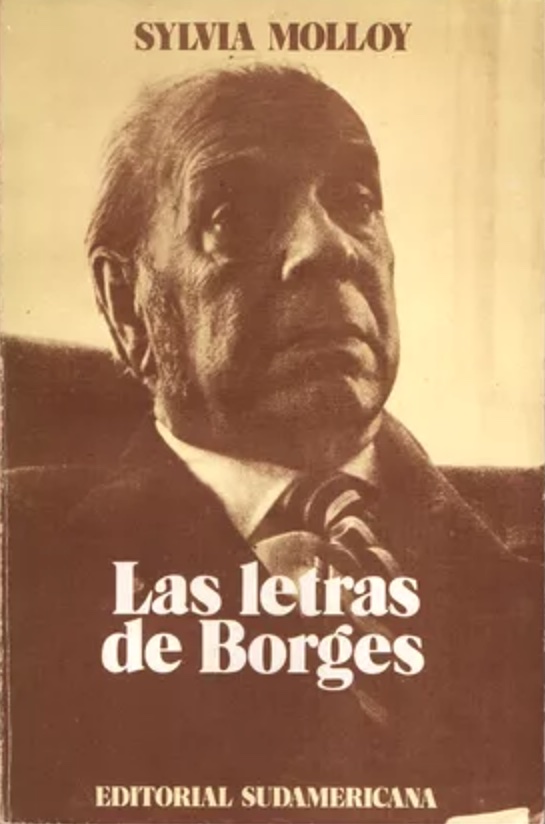 Las letras de Borges By Sylvia Molloy Editorial Sudamericana, 1979 |
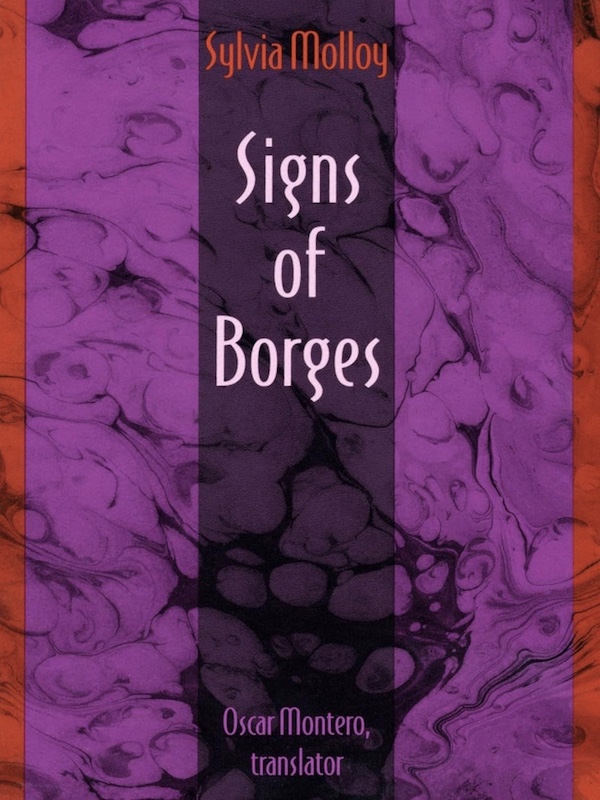 Signs of Borges By Sylvia Molloy Translation by Oscar Montero Duke University Press, 1994 Online at: Internet Archive |
Born in Buenos Aires in 1938, Sylvia Molloy is a novelist and literary critic who taught at Princeton, Yale, and NYU. She specializes in LGBTQ issues and “autobiography as a genre.” In 1979 she published Las letras de Borges, an influential work of early Borges scholarship. In the early 1990s, Molloy worked with translator Oscar Montero to produce an English edition of the book, released by Duke University Press as part of its “Post Contemporary Interventions” series edited by Stanley Fish and Fredric Jameson.
Publisher’s Description: Available for the first time in English, Signs of Borges is widely regarded as the best single book on the work of Jorge Luis Borges. With a critical sensibility informed by Barthes, Lacan, Foucault, Blanchot, and the entire body of Borges scholarship, Sylvia Molloy explores the problem of meaning in Borges’s work by remaining true to the uncanniness that is its foundation. Borges’s sustained practice of the uncanny gives rise in his texts to endless tensions between illusion and meaning, and to the competing desires for fragmentation, dispersal, and stability. Molloy traces the movement of Borges’s own writing by repeatedly spanning the boundaries of genre and cutting across the conventional separations of narrative, lyric and essay, fact and fiction. Rather than seeking to resolve the tensions and conflicts, she preserves and develops them, thereby maintaining the potential of these texts to disturb. At the site of these tensions, Molloy locates the play between meaning and meaninglessness that occurs in Borges’s texts. From this vantage point his strategies of deception, recourse to simulacra, inquisitorial urge to unsettle binarism, and distrust of the permanent—all that makes Borges Borges—are examined with unmatched skill and acuity. Elegantly written and translated, Signs of Borges presents a remarkable and dynamic view of one of the most international and compelling writers of this century. It will be of great interest to all students of twentieth-century literature, particularly to students of Latin American literature.
Table of Contents:
Preface
Introduction
1. Shadow Plays
2. Textual Rubrications
3. Fragments and Greeks
4. Postulating a Reality, Selecting a Reality
5. Converting the Simulacrum
6. Pleasure and Perplexity
7. The Buried Foundation
Abbreviations
Notes
Index
Reviews: Debra A. Castillo’s review appeared in Modern Fiction Studies, Vol. 40, No. 2 (Summer 1994): pp. 391–393, [Project MUSE paywall].
Jorge Luis Borges
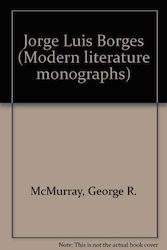
Jorge Luis Borges
By George R. McMurray
Frederick Ungar, 1980
Online at: Internet Archive
George R. McMurray has written upon several Latin American writers, including Gabriel García Márquez, Mario Vargas Llosa, and Jorge Luis Borges. According to the publisher Frederick Ungar, Murray’s monograph “traces the development, and growing impact, of the Argentinian writer’s genius and craft, noting the manifestations in Borges’s stories of important and recurrent motifs, ideas, figures, techniques, and attitudes.” The back of the book declares that “Borges’ writings are imbued with a metaphysical fantasy that brings to mind the work of J.R.R. Tolkien. Borges’ absurdist view of the universe finds voice in his best-known works—Labyrinths, Dr. Brodie’s Report, and The Book of Sand.” Putting aside the bizarre Tolkien comparison, I’m not sure why Ungar decided these Borges works were better known than Ficciones!
Table of Contents: Jorge Luis Borges is organized into themes, each which examines various Borges stories relating to that topic:
Chronology
Introduction
I. Borges and the Absurd Human Condition
1. The Philosophy of the Absurd
2. The Negation of Reason
3. Idealism
4. Pantheism
5. The Treatment of Time
6. The Double and the Mirror Image
7. The Machismo Cult
II. Some Aspects of Borges’ Esthetics
1. The Esthetic Ideal
2. The Symbolic Vision
3. Irony and the Point of View
4. Stylistic Elements
III. Final Word
Notes
Bibliography
Index
Borges and His Fiction
A Guide to His Mind and Art
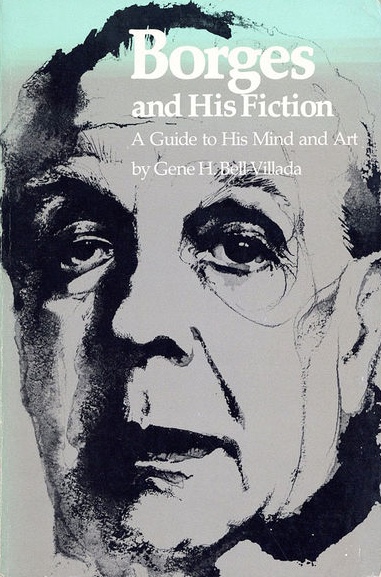 Borges and His Fiction: A Guide to His Mind and Art By Gene H. Bell-Villada University of North Carolina Press, 1981 Online at: Internet Archive |
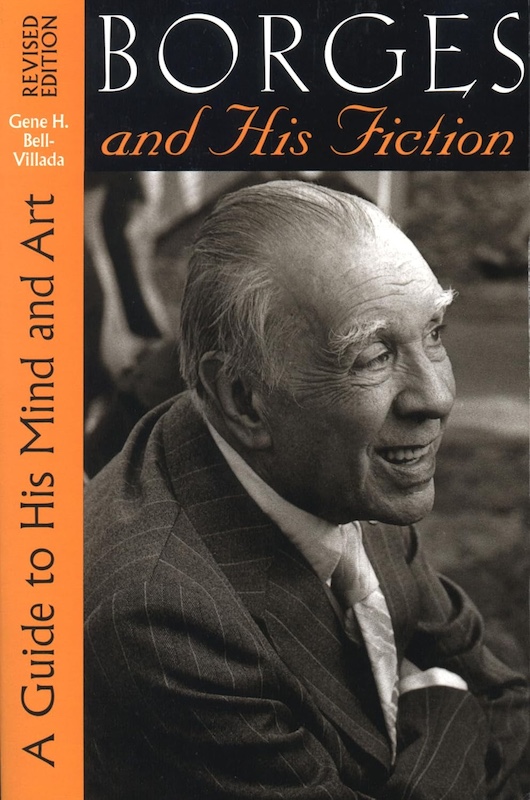 Borges and His Fiction: A Guide to His Mind and Art [Revised Edition] By Gene H. Bell-Villada University of Texas Press, 2000 Online at: JSTOR [Paywall] |
Born in Haiti and raised in the Caribbean, Gene H. Bell-Villada is an American writer and literary critic who teaches at Williams College and specializes in Latin American literature. Borges and His Fiction: A Guide to His Mind and Art is his first book, written in 1981 and revised two decades later. Although the title is amusingly ambitious, Bell-Villada’s book is refreshingly readable, an enthusiastic appreciation of Borges written in a lucid, conversational style that avoids condescension and academic inscrutability. By focusing on the core fictions that form the foundation of Borges’ reputation, Bell-Villada ensures a sense of relevance for the general reader. If you are planning to read one book of general Borges criticism, this would be an excellent choice!
Publisher’s Description: Since its first publication in 1981, Borges and His Fiction has introduced the life and works of this Argentinian master-writer to an entire generation of students, high school and college teachers, and general readers. Responding to a steady demand for an updated edition, Gene H. Bell-Villada has significantly revised and expanded the book to incorporate new information that has become available since Borges’ death in 1986. In particular, he offers a more complete look at Borges and Peronism and Borges’ personal experiences of love and mysticism, as well as revised interpretations of some of Borges’ stories. As before, the book is divided into three sections that examine Borges’ life, his stories in Ficciones and El Aleph, and his place in world literature.
Table of Contents:
Preface to the Revised Edition
Preface to the 1981 Edition
Chronology
Part I: Borges’ Worlds
-
- Buenos Aires and Beyond
- A Sort of Life, a Special Mind
- What Borges Did for Prose Fiction
Part II: Borges’ Fictions
-
- The Apprentice Fiction Maker
- Ficciones I: Doubles, Dreamers, and Detectives
- Ficciones II: The World within a Book
- El Aleph I: Doubles and Puzzles
- El Aleph II: Tales of Action and Violence
- El Aleph III: The Visionary Experience
Part III: Borges’ Place in Literature
-
- Dreamtigers and Later Works: A Tentative Summation
- Literature and Politics North and South
- Borges as Argentine Author: And Other Self-Evident (If Often Ignored) Truths
Abbreviations
Notes
Selected Bibliography
Index
Reviews: Katherine S. Kovács’s review of Borges and His Fiction was published in International Fiction Review, Vol. 9, No. 2 (1982), [Journal Lib PDF]. William Slaymaker’s review appeared in Philosophy and Literature, Vol. 6, No. 1 & 2 (Fall 1982): pp. 218–219, [Project MUSE paywall].
Simply a Man of Letters
Panel Discussion and Papers from the Proceedings of a Symposium on Jorge Luis Borges Held at the University of Maine at Orono
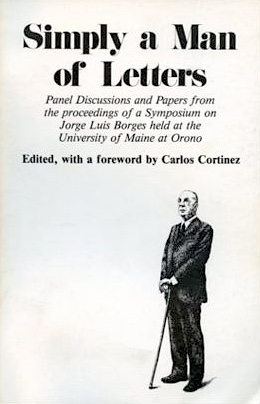
Simply a Man of Letters: Panel Discussion and Papers from the Proceedings of a Symposium on Jorge Luis Borges Held at the University of Maine at Orono
Edited by Carlos Cortínez
University of Maine Press, 1982
Online at: Internet Archive | Borges Center [Part 1] [Part 2]
In 1975, Jorge Luis Borges was the subject of a symposium held at the University of Maine, and this book collects the papers presented at the symposium. Borges himself was in attendance. The collection was edited by Carlos Cortínez (1934-2016), a poet and professor of Spanish at Dickinson College.
Table of Contents:
Foreword
Jorge Luis Borges, “Simply a Man of Letters”
I. Papers
-
- Jaime Alazraki, “Outside and Inside the Mirror in Borges’ Poetry”
- Ana María Barrenechea, “Borges and the Symbols”
- Robert C. Carroll, “Borges and Bruno: The Geometry of Infinity in La Muerte”
- Ronald Christ, “Forking Narratives”
- Alexander Coleman, “On the Concept of Romance in Borges”
- Eugenio Donato, “Topographies of Memory”
- Zunilda Gertel, “Identity as Discourse and Image in the Poetry of Borges”
- Burton Hatlen, “Borges and Metafiction”
- James E. Irby, “Some Notes on Pierre Menard”
- Humberto Rasi, “Borges In Search of the Fatherland”
- Emir Rodríguez-Monegal, “Borges: The Intellectual Background”
- Emma Susana Seratti-Piñero, “The Rose in Borges’ Works”
- Stephen L. Weber, “Jorge Luis Borges, Lover of Labyrinths: A Heideggerian Critique”
- Donald A. Yates, “Jorge Luis Borges and Adolfo Bioy Casares: A Literary Collaboration”
II. Panels
-
- Borges and Chesterton
- On Translating Borges
- Borges: Philosopher, Poet Revolutionary…?
III. Readings
-
- Georgette Dorn, “Borges in the Library of Congress”
- Jorge Luis Borges, “Commentaries of Five Poems”
IV. New Poems
V. Homage
-
- Jaime Alazraki, “Borges”
- Willis Barnstone, “Borges Blind” and others
- Carlos Cortínez, “Orono” and others
- Alan Dugan, “On Finding the Tree of Life”
- William Ferguson, “Prose Poem for Borges”
- Jorge Guillén, “Jorge Luis Borges,” “Un Saludo”
- Oscar Hahn, “Noche oscura del ojo”
- James Hoggard, “Tiresias, Weaver”
- Karl Kopp, “To Jorge Luis Borges”
- Robert Lima, “Touches,” and others
- Dave Oliphant, “Rebirth for Jorge Luis Borges”
- Antonio Requeni, “Apuntes”
- Eliana Rivero, “Para una experiencia circular”
- Gonzalo Rojas, “Para caer a Borges”
- Rainer Schulte, “Borges”
- Mará Esther Vásquez, “Recordando a Borges”
- Miller Williams, “Hecho, hecho (w/love) for Borges”
- Thomas Montgomery, “My Collaboration with orfelín Torres”
VI. Program of the Symposium
Reviews: Thorpe Running’s review of Simply a Man of Letters was published in Chasqui, Vol. 12, No. 1 (Nov. 1982): pp. 104–106, [JSTOR paywall]. Running himself attended the conference, but did not present any papers. His review is lengthy, but worth quoting in full, and is notable for its enthusiasm and refreshingly informal tone. If all reviews of academic works could be this “lively,” the world would be a brighter place:
As its subtitle makes explicit, this book is a record of the “Panel Discussions and Papers from the Proceedings of a Symposium on Jorge Luis Borges Held at the University of Maine at Orono.” Fortunately not as dry as that subtitle might indicate, the book is both informative and interesting. Although any collection like this is bound to be somewhat uneven in quality, Simply a Man of Letters contains several sparkling contributions, as might be expected from a cast of well-known borgistas taking part in this conference. Remarkably, even with the diversity of contents there is a general unity of tone, broken only by occasional pedantic or jargon-filled pieces. Beginning with the brief and witty introduction by editor Cortínez, a sense of warmth and good humor runs through much of the book, making lively reading of its serious and perceptive scholarship.
Indeed, the only substantive criticism that I want to make, and it is something that Carlos Cortínez himself discusses in his introduction, regards the unconscionable delay in publication. The symposium took place in 1975 and the publication date for its proceedings is 1982. Although not all of the contents have been superseded in the intervening years, some of the papers have naturally lost a degree of interest: Emir Rodríguez-Monegal’s presentation on Borges’ intellectual background forms part of his large “literary biography” already published several years ago; Jaime Alazraki’s excellent article, “Outside and Inside the Mirror in Borges’ Poetry” has been fitted into his Versiones, inversiones, reversiones (Gredos, 1977); and Robert C. Carroll’s article on “Borges and Bruno” is a reprint from Modern Language Notes. In any case, much of this collection contains essential material for Borges scholars and aficionados alike, and it is a shame to have postponed its availability.
Rather than catalog, or try to summarize, all of the contents of Simply a Man of Letters, I prefer to point out what strikes me as being its highlights. In itself worth the price of the book is the first piece, a talk by Borges entitled “Simply a Man of Letters.” The topic is the writer’s relationship to language, to words. Borges development of this theme shows, not surprisingly, how integral language is to his life, and how an obsession with words can in turn generate new literary production. Much of what he says here, though not all of it new, bears significantly on both his prose and his poetry.
Among the papers given at the conference, several stand out. Zunilda Gertel discusses in a thorough and scholarly fashion the function of subjectivity and the poetic persona (“Identity as Discourse and Image”) in Borges’ recent poetry. In a spirited discussion of “the concept of Romance in Borges,” Alexander Coleman explains how the principles of the genre more fittingly encompass what is often termed “fantastic” literature in Latin America: “I mean, in a word, a vision that is not continually bifurcated between reality versus fantasy… I mean an absolute fusion of the two.” Just as lively, and witty to boot, is Ronald Christ’s treatment of “Forking Narratives” dealing with the ways in which Borges’ technique of “alternate plotting” has been picked up, in particular, by Robert Coover (in Pricksongs and Descants) and Nicolas Roeg (in his film, Performance). Donald Yates’ paper examines the literary collaboration between Borges and Adolfo Bioy Casares, an area not often treated by critics.
Most impressive, however, is James Irby’s modestly titled piece, “Some Notes on ‘Pierre Menard’.” In elegant, seemingly effortless prose, Irby does a parallel reading of Borges’ short story and Ronald Barthes’ own reading of Balzac’s Sarrasine in S/Z. Not only does Irby’s prose echo Barthes’ sleek and precise language, but his method of analysis sheds much light on the French critic’s work as it does on Borges’ story—no mean accomplishment, since his critique of “Pierre Menard” is superb.
The panel discussions transcribed toward the end of the book, despite some inevitable uninspired moments, tend on the whole to be lively, insightful, and informative. The first, on “Borges and Chesterton” (with Enrique Anderson-Imbert, Robert Gillespie and Robert Scholes) will provide few surprises for readers of Borges criticism. The second, “On Translating Borges,” makes up for the first session’s lack of novelty by being doubly informative. Donald Yates begins the session by giving a lengthy and complete history of the procedures involved in making Borges’ writing available in English, a process which he, of course, was intimately involved quite early on. Then William Ferguson, Willis Barnstone, Alan Dugan and Robert Lima all give sprightly and fervid accounts of their experiences while collaborating with Norman Thomas di Giovanni on the translation of Selected Poems of Borges. That kind of insider’s professional gossip, besides spicing up the proceedings, lays bare some deeply held ideas regarding how translations should be done.
The final panel, titled “Borges: Philosopher? Poet? Revolutionary,” (sic) is highlighted by another spirited interchange, this time between Jaime Alazraki and Emir Rodríguez-Monegal, with Borges as intermediary. The topic is Borges’ revolutionary style of prose in Spanish. Alazraki, whose credentials as a student of Borges’ style are well established, states that the Argentine’s “new” Spanish prose is really a transformation of what was already being done in English literature. According to Alazraki, “when we move to the English language we find that those attributes Borges sought for Spanish prose were already part of English prose at least since the turn of the nineteenth century.” “In fact,” he says,” English has been often for Borges a model for the Spanish he set out to forge.” Borges himself interjects at this point, saying that his prose style comes from Paul Groussac and Alfonso Reyes, a point that Emir Rodríguez-Monegal agrees with and expands upon, emphasizing the first of those two influences. Instead of the influence of English, then, ERM sees the French, as he states adamantly: “what actually happened was that Borges went to Geneva and learned French there, and the syntax in mainly French with some touches of Groussac.” Needless to say, the ensuing discussion, if inconclusive, does engage the reader’s attention.
The book ends with some of the poems written for, and read at, the conference. Since they are more celebratory than substantive, these poems will probably least interest readers of Simply a Man of Letters.
Clearly, Carlos Cortínez is to be thanked for having brought together such a sterling cast of scholars, and for having made these proceedings available to a larger audience. This book, with its goodly number of inspired moments, can be recommended for both graduate and undergraduate libraries.
—Thorpe Running, 1982
The Prose of Jorge Luis Borges
Existentialism and the Dynamics of Surprise
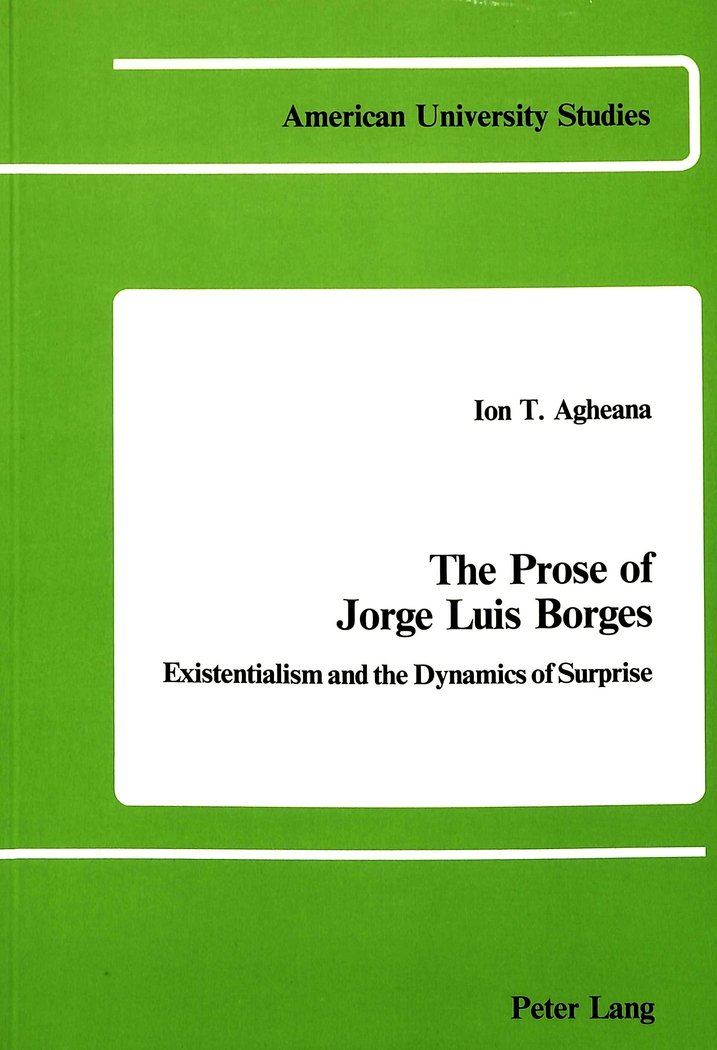
The Prose of Jorge Luis Borges: Existentialism and the Dynamics of Surprise
By Ion T. Ageana
Peter Lang, 1984
Online at: Internet Archive
Born in Romania, Ion T. Agheana (1937-2018) was a professor of Romance Languages at Dartmouth, and later Hope College. His two areas of specialty were Jorge Luis Borges and the Romanian philosopher Emil Ciora. The Prose of Jorge Luis Borges is a lengthy work, and Peter Lang does Ageana no favors by publishing the book in double-spaced typeface!
Publisher’s Description: Like the Kafka of one of his essays, Jorge Luis Borges imposes himself at first as a man of iconoclastic singularity, as a writer who, having considered and discarded seemingly all the “isms” of literature and philosophy, creates a world ex nihilo. Yet minutely studied, Borges, like Kafka, who under close scrutiny reveals subtle affinities with other literatures, exhibits an unmistakable existential strain. The analysis of Borges’ existentialism, identifiable in his prose works not as a unitary system but as a philosophical premise, together with the dynamics of surprise, constitute the object of the present study.
Jorge Luis Borges: Life, Work, and Criticism
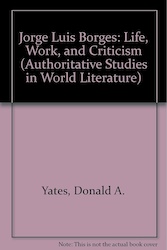
Jorge Luis Borges: Life, Work, and Criticism
By Donald A. Yates
York Press, 1985
Donald A. Yates is a central figure in Borges scholarship. One of Borges’ first English-language translators, Yates’ Labyrinths helped expose Borges to an American audience. He has translated Bioy Casares, written numerous essays and book reviews about Latin American literature, and currently serves as professor emeritus of Spanish American literature at Michigan State University. According to the New Directions web site, Yates is currently working on a Borges memoir. Jorge Luis Borges: Life, Work, and Criticism is part of the Authoritative Studies in World Literature series. Only 41 pages long, it offers a concise summary of Borges and his work for students.
Reviews: James E. Holloway’s review of Jorge Luis Borges was published in International Fiction Review, Vol. 13, No. 2 (1986), [Journal Lib PDF]. George R. McMurray’s review appeared in Hispanic Review, Vol. 55, Issue 1 (Winter 1987): 134–135, [ProQuest paywall]. Rosemary Geisdorfer Feal’s review appeared in Revista de Estudios Hispánicos, Vol. 22, Issue 3 (Oct 1, 1988): pg. 143, [ProQuest paywall].
The Literary Universe of Jorge Luis Borges
An Index to References and Allusions to Persons, Titles, and Places in His Writings
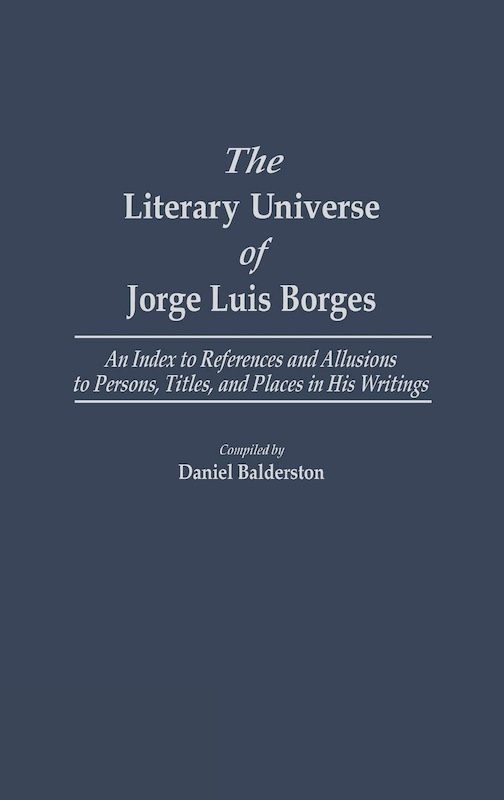
The Literary Universe of Jorge Luis Borges: An Index to References and Allusions to Persons, Titles, and Places in His Writings
By Daniel Balderston
Greenwood Press, 1986
A preeminent Borges scholar and literary critic, Daniel Balderston is currently the Mellon Professor of Modern Languages at the University of Pittsburgh. He is also the chair of the Borges Center and the editor of Variaciones Borges. Volume 9 in the “World Literature, Bibliographies and Indexes” series, The Literary Universe of Jorge Luis Borges is not a compendium but an index, intended primarily for academics. Although this book is long out of print, much of Balderston’s work indexing Borges continues with the Borges Center; especially its remarkable Borges Timeline and Finder’s Guide.
Publisher’s Description: Balderston’s compilation is defined by its subtitle. The work is a comprehensive labor of literary love providing for the dedicated Borges fan or scholar the location in his works of allusions to people, titles, and places. The most impressive facet of the compilation, apart from the sheer enthusiasm necessary to undertake and complete it, is the breadth and depth of Borges’ knowledge, which encompasses all cultures and all ages. The index gives a sense of Borges’ encyclopedic mind. Aside from attesting to Borges’ brilliance, the index will be useful for students of Hispanic literature and of Borges himself….
Modern Critical Views: Jorge Luis Borges
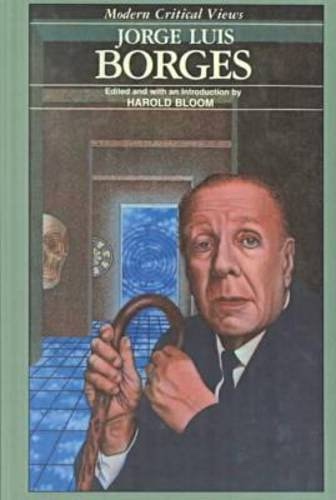
Modern Critical Views: Jorge Luis Borges
Edited by Harold Bloom
Chelsea House, 1986
Online at: Internet Archive
One of the United States’ genuine literary lions, Harold Bloom (1930-2019) was an influential scholar and critic, a celebrated Shakespearian, and a famously staunch defender of the Western canon. A professor at Yale University for over sixty years, Bloom published dozens of books, from explorations of the Kabbalah to The Anxiety of Influence, a key work of twentieth-century literary criticism. Indeed, Bloom’s name became something of a brand, and finds itself on three separate books about Borges!
Publisher’s Description: This title, Jorge Luis Borges, part of Chelsea House Publishers’ Modern Critical Views series, examines the major works of Jorge Luis Borges through full-length critical essays by expert literary critics. In addition, this title features a short biography on Jorge Luis Borges, a chronology of the author’s life, and an introductory essay written by Harold Bloom, Sterling Professor of the Humanities, Yale University.
Table of Contents:
- Thomas R. Hart, Jr., “Borges’ Literary Criticism”
- Paul de Man, “A Modern Master”
- Louis Murillo, “Three Stories”
- Ronald J, Christ, “The Immortal”
- Jaime Alazraki, “Kabbalistic Traits in Borges’ Narration”
- James E. Irby, “Borges and the Idea of Utopia”
- Carter Wheelock, “Borges’ New Prose”
- Emir Rodríguez-Monegal, “Symbols in Borges’ Work”
- Alicia Borinsky, “Repetition, Museums, Libraries”
- John Sturrock, “Odium Theologicum”
- Nancy B. Mandlove, “Chess and Mirrors: Form as a Metaphor in Three Sonnets”
- Shlomith Rimmon-Kenan, “Doubles and Counterparts: The Garden of Forking Paths”
- Ricardo Gutiérrez-Mouat, “The Center of the Labyrinth”
- Thorpe Running, “Borges’ Ultraist Poetry”
- Roberto González-Echevarría, “Borges and Derrida”
Borges Criticism
Main Page — Return to the Borges Criticism main page and index.
General Criticism 2 — General literary criticism and commentary written from 1987 to 1999.
General Criticism 3 — General literary criticism and commentary written from 2000 to the present.
Poetics — Criticism written about Borges’ poetry and poetics.
Comparative Criticism — Borges criticism that compares Borges with other writers or locates Borges’ work within a broader literary context such as genre fiction or Latin American Literature.
Political & Theoretical Criticism — Borges criticism with a strong political, theoretical, or philosophical component: Marxist critique, postmodernism, postcolonial studies, gender studies, queer theory, disability studies, etc.
Religious & Esoteric Criticism — Borges criticism from a religious, metaphysical, or esoteric perspective.
Scientific Criticism — Borges criticism within the disciplines of science, mathematics, and technology.
Author: Allen B. Ruch
Last Modified: 22 August 2024
Main Borges Page: The Garden of Forking Paths
Contact: quail(at)shipwrecklibrary(dot)com

